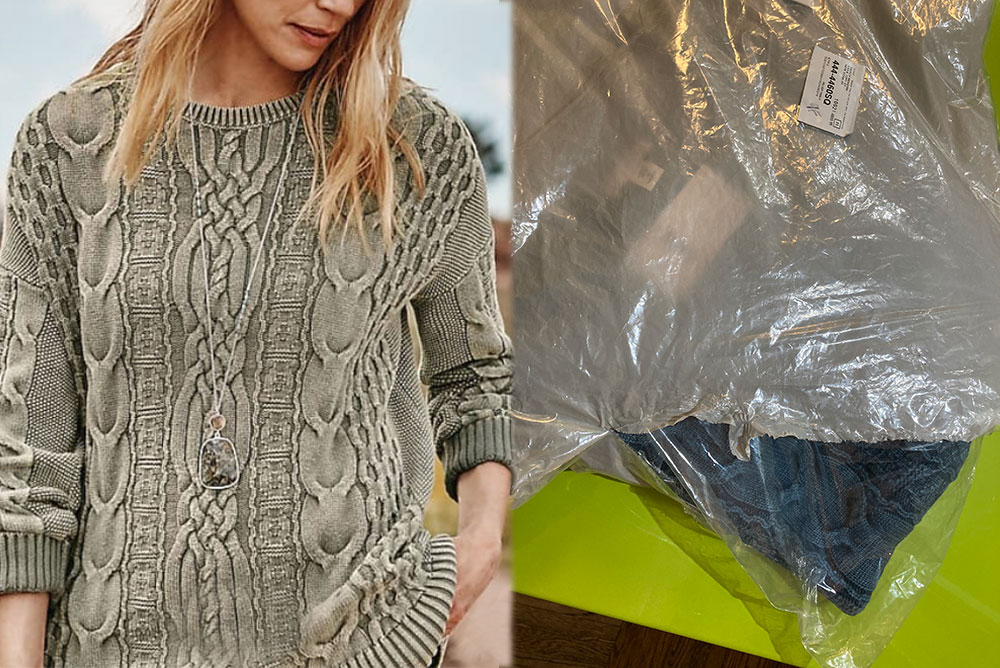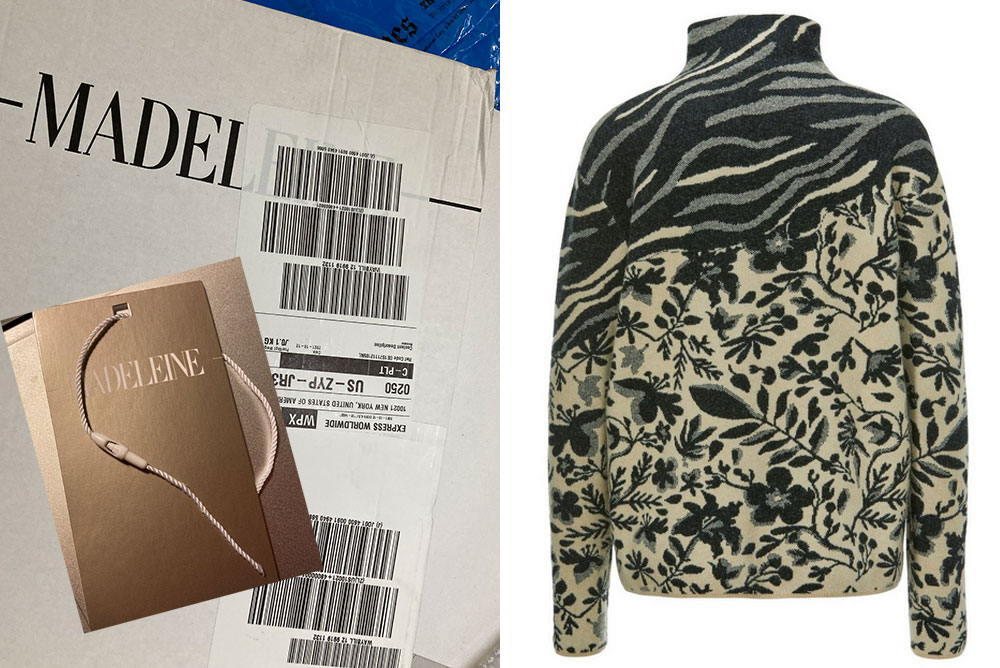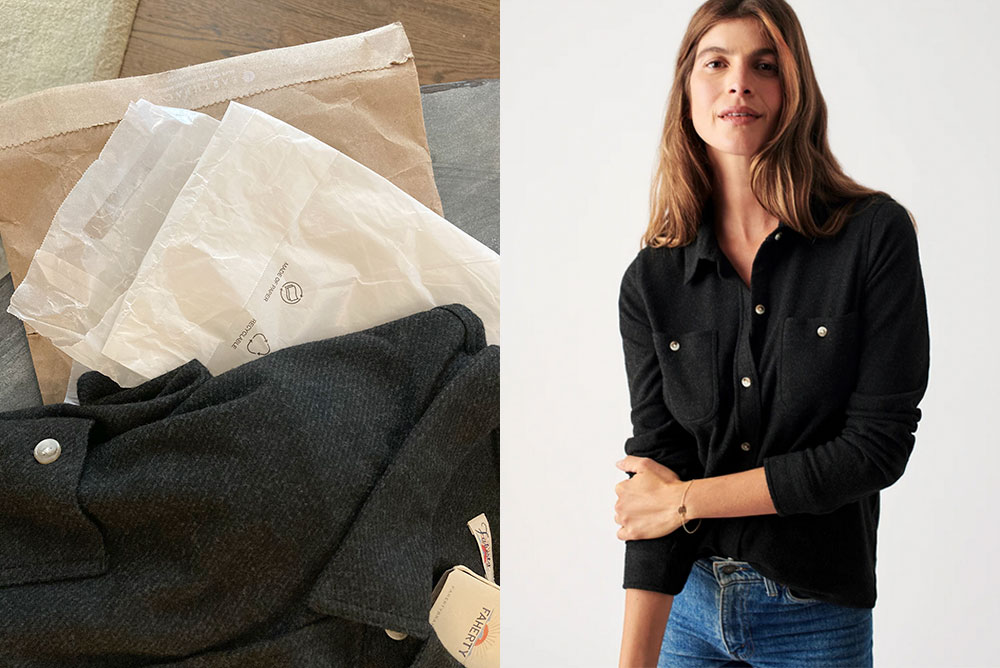
A nice all-cotton stone-washed sweater from J.Jill arrived in a not-so-nice plastic outer bag and plastic inner bag, both of which I recycled as dog-poop bags.
IT STARTED to get a little nippy a few weeks ago, and the linen shirts hanging in my closet began to seem less appealing. So I thought I’d up my sweater count, from (believe it or not) two to maybe three or four (big grownup girls tend not to go for added bulk).
My favorite mid-level catalogues came cascading in and were happy to oblige. J.Jill offered a cable-stitch cotton sweater in stonewashed denim color (sorry, “ink heather”) or “smoky olive.” Madeleine, an aggressive-looking new (to me) large-format catalogue out of Germany, had a sweater in an interesting gray-and-black pattern with a funnel neck that looked easy to wear. And Faherty, a company I didn’t know, showed a “Legend” shirt-style Heathered Black Twill sweater. So I pulled the trigger, three times.
Then the packages started arriving. As we all no doubt know, UPS, Fedex and the US Post Office are doing handstands these days to deliver all the bits and pieces that Americans want/need and have learned are easier to get online, whether from traditional brick-and-mortar stores (when’s the last time you heard that term!?) or e-tailers. The elegant lobby of the Manhattan apartment building where I live has turned into a warehouse receiving department—and the doormen into receiving clerks, not a huge part of their previous job description.

Madeleine’s “sesame/multicolor” sweater arrived in a lovely (but process-heavy) white box, but the sweater itself was encased in a plastic bag, and the heavy-cardboard tag was attached with a string and a—why?—plastic fastener.
First to arrive was J.Jill, in its basic gray/beige plastic envelope. Inside, the sweater was in yet another plastic bag, this one clear. Not lovely, for sure. The sweater was too large, so it went back for a smaller size, and therefore another plastic envelope and another plastic bag.
Then came the Faherty shirt, a revelation: The outside envelope was a paper Earthpack envelope, made by a company with a fairly dysfunctional website “with 100% recycled material.” And inside, the shirt was in a recyclable bag that proclaimed it was “made of paper.”
Madeleine’s contribution to my front hallway arrived in a white cardboard box, clean-looking but a finish that requires more finish work than plain brown cardboard. Inside, another plastic bag. And this from a company in Germany, where the Greens have had a major success and retailers have in the past been required to take back all the excess packaging from purchases and recycle it.
But here’s the odd thing: The J.Jill sweater, in all its plastic packaging, was made of all cotton. The Faherty shirt, so supple and soft and packaged in eco-conscious recyclable paper? Not a natural fiber in sight! It’s made of polyester, viscose (a semi-synthetic fiber, I read) and spandex. And Madeleine’s sweater has a recipe worthy of a spice rub: 50% wool, 21% cotton, 18% nylon, 10% cashmere, 1% spandex.

The “Legend” sweater shirt from Faherty arrived in a paper Earthpack. Inside, the shirt was nestled in a paper envelope that resembled waxed paper. Its tag was cardboard and attached with regular string.
I’m not at all a purist. I have learned to love all those little polyesters and their synthetic friends. But I also love to open a box and see the goods held in place with crumpled Kraft paper instead of Sealed-Air “inflatable cushioning” or whatever they’re calling Bubble Wrap these days. And I like getting one giant box from Costco instead of seven separate deliveries from Amazon’s various vendors.
There’s too much waste in this new world of our making, and I’m a big part of it.

I used to live in a condo and my packages never had to deal with sitting out in weather. Since moving into a house I’ve come to LOVE things delivered in plastic. The packages in paper and cardboard become soggy messages when left on my top step in the rain.
Granted, plastic has its uses, especially as you point out. It’s mostly the plastic innards that make me crazy. But it sure doesn’t make me feel I’ve bought a very nice piece of clothing when it arrives in what is essentially a heavy-duty garbage bag! (Okay, I exaggerate, but not by much.) Still, I take your point.
Great article and timely, I think. With the holidays around the corner maybe some of these companies will rethink their packaging when they see articles like this. Good going!
Holly
P.S. It is phenomenal how fast our distaste for anything that contributes to climate change is growing.
Yes! I spend lot of time sorting my recyclable stuff. I cringe to think about all the years I just trashed everything adding to landfills so now I’m trying to make up for it. Our county has a compost program, I take all my plastic and plastic wrap to the bin at the grocery store (hoping it gets recycled) I save every bit of bubble wrap and those bubbled envelopes from Amazon, waiting for someone to need them for packing to move . And don’t get me started on straws…
I hear you! But what drives me nuts is all the ways manufacturers and retailers manage to thwart our good intentions (and often their pious declarations). To wit: Apparently, those chaste-looking cardboard coffee cups and ice-cream tubs that we see as ecologically helpful alternatives to plastic are lined with—-ready?—-plastic, to ensure that they can do their job. Chobani-brand plastic yogurt cups have a very helpful little perforated line up the side and a note telling me to remove the plastic wrapper that has all the images and info on it, then recycle the plain plastic container. My Sodastream-brand flavor bottles, wrapped in similar fashion, have no such instruction and certainly no perforation to help the denuding of the bottle. Does a perforated line cost extra? Probably. Does every penny count? Evidently. Thousands of similar calculations, with an eye on the bottom line, are made by manufacturers every day. And just about every week some object enters my life with some part of it made of plastic, a part that used to be cardboard or metal or whatnot. It’s a push-me, pull-you exercise that keeps the American economy afloat and has our future reaching flood stage.